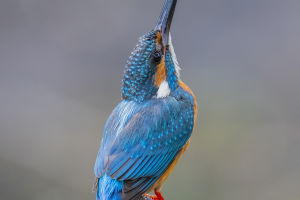The Koala, scientifically known as Phascolarctos cinereus, is an arboreal marsupial native to Australia.
It belongs to the marsupial family, along with kangaroos and wombats.
Koalas are renowned for their rounded bodies, large round ears, and short dense gray fur.
They are generally perceived as lethargic creatures that spend most of their time sleeping, particularly during daylight hours.
Koalas primarily subsist on leaves, with eucalyptus leaves being their main dietary staple.
Their digestive systems have evolved to handle the fibrous nature of eucalyptus leaves.
These adorable creatures have become iconic symbols of Australia and are immensely popular worldwide.
Unfortunately, koalas face numerous threats due to habitat destruction, wildfires, and other factors, resulting in their classification as a Vulnerable species by the International Union for Conservation of Nature (IUCN).
To safeguard their survival, Australia has implemented various measures such as establishing protected areas, imposing restrictions on eucalyptus tree logging, and educating the public on the significance of koala conservation.
It is crucial to note that koalas are wild animals and are not suitable as pets.
Outside of Australia, obtaining a special license and complying with relevant laws and regulations is mandatory for those considering keeping koalas.
Preserving koalas' natural habitats and ensuring their well-being is pivotal in securing the future of this rare species.
Let's delve into the distinctive behavioral traits of koalas:
1. Habitat: Koalas predominantly inhabit the eastern coastal regions of Australia, including Queensland, New South Wales, Victoria, and South Australia. They gravitate towards densely wooded environments such as forests, jungles, thickets, and eucalyptus groves.
2. Arboreal Lifestyle: Koalas are arboreal creatures adept at climbing trees using their claws and robust forelimbs.
Their powerful hind limbs and feet assist in maneuvering between branches.
Typically, koalas select a primary "home tree" where they spend the majority of their time.
3. Nocturnal Habits: Koalas are nocturnal animals, displaying peak activity and foraging behavior during nighttime hours while devoting most of their day to slumber.
They frequently seek out recesses or hollows in tree branches as secure and concealed sleeping spots.
4. Feeding Patterns: Koalas are herbivores with a diet primarily consisting of eucalyptus leaves.
Eucalyptus leaves pose a challenge for most animals due to their high cellulose content, but koalas possess specialized digestive systems to process this fibrous food source.
Their digestive tract includes a unique liver adaptation that aids in breaking down toxins and cellulose found in eucalyptus leaves, providing them with energy and essential nutrients.
5. Social Behavior: Koalas tend to be solitary creatures, focused on foraging and establishing territories.
Male koalas engage in territorial disputes, employing roaring and physical confrontations to delineate boundaries.
On the other hand, female koalas typically reside with their cubs.
6. Breeding and Cubs: Koalas breed during the spring and summer seasons.
The gestation period for female koalas lasts approximately 35 to 38 days, resulting in the birth of a single cub.
Koala cubs are born extremely underdeveloped, hairless, and blind.
However, they instinctively crawl into their mother's pouch for further development.
Cubs rely on their mother's milk and the protection of the pouch, emerging from it at around 6 to 7 months of age.
These behaviors exemplify the fascinating characteristics of koalas.
These captivating creatures, adored for their languid nature and adorable appearance, hold a special place in the hearts of people worldwide.


